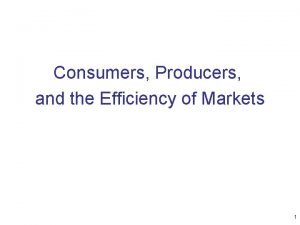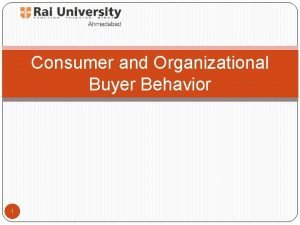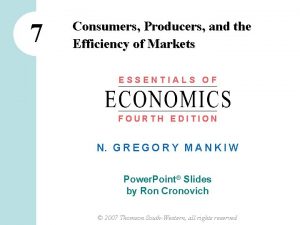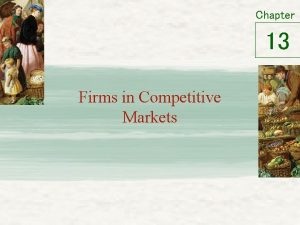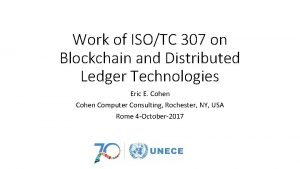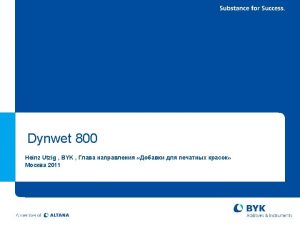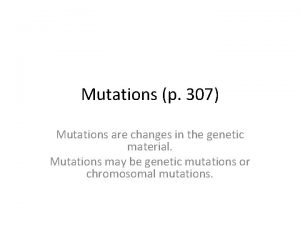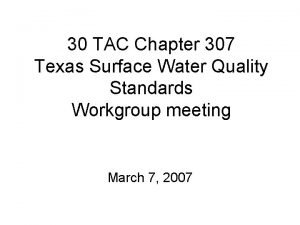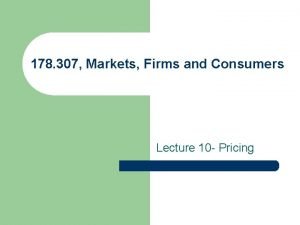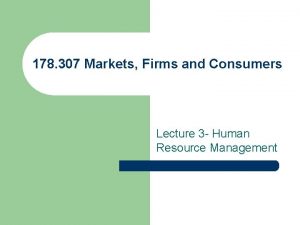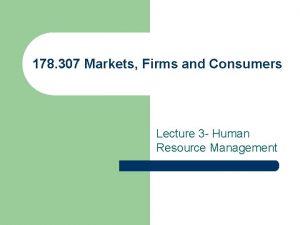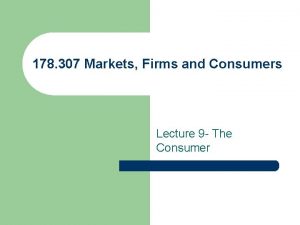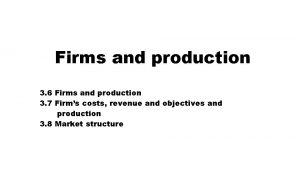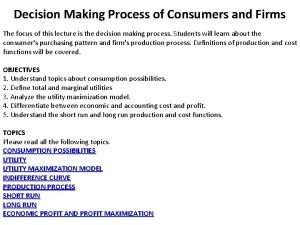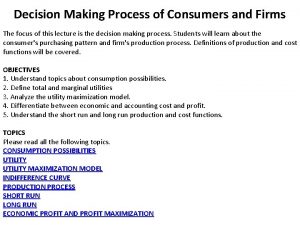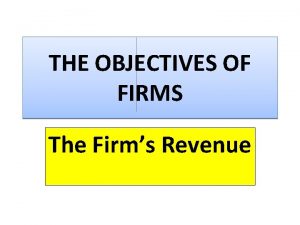178 307 Markets Firms and Consumers Lecture 11
























- Slides: 24

178. 307 Markets, Firms and Consumers Lecture 11: Competition

Overview l l Firms interact with other firms. This is often in various forms of competition. l Keywords – – – Cournot Model Stackleberg Model Betrand Model Hotelling Model Salop Model Predatory Pricing

Neoclassical Models l l Both Cournot and Betrand Models can be solved by Game Theory. Cournot Model has firms competing on output. l l Bertrand Market has firms competing on price. Collusion is much less stable in a Betrand market.

Cournot Model l See tutorial exercises

Betrand Duopoly

Reaction Functions Note: this implies a firm will increase (decrease) its price if its competitors increase (decrease) theirs. l Solve (simultaneously) for all firms and find that all optimal prices are: (a+c)/(2 -b)

Stackelberg Model l Game is similar to Cournot Outputs are no longer selected simultaneously. We make one firm the leader. l l l The solution is by ‘backward induction’. We use the terminal point of the game to determine the follower’s output. This used to derive the leader’s output.

Stackelberg Game

Solutions l l Leader obtains larger share of market (first-mover advantage) In Cournot model the share is (a-c)/3 b each.

Simple Spatial Competition l Hotelling Model (1929) – See tutorial

Salop Model- Introduction l l l Depositors are uniformly located along a circle. There are n banks, indexed by i= 1, . . , n. Banks invest cash in a riskless technology with a return of r. Depositors don’t have access to technology. Transport costs of αx are incurred by each depositor, where x is ‘distance’. • Each depositor has 1 unit of cash. • The Total Length of the circle = 1 • Total mass of depositors =D

Optimal Organisation l l The most distance any consumer will travel to a bank is 1/2 n (halfway round the circle). The sum of all transport costs are Note: you don’t need to prove this.

Optimal number of banks l l Let the unit cost of setting up a bank is F. Optimal number is found by minimising setup and transport costs:

Solution

Define the marginal depositor

Volume of Deposits l Total volume of deposits are ‘doubled’ to take account of banks both sides of the bank i.

Profit of Bank i The solution here requires the use of the product rule

Simplify l Only one solution is possible, if all banks charge the same interest rates…

Profit of Bank

Free Competition Output l l l Free competition leads to too many banks This provides scope for regulation Note that decreasing ‘r’ (e. g. by reserve requirement) has no effect.

Predatory Pricing l A firm sets prices below cost, in an attempt to drive competitors out of the market. – – It hopes to recoup losses after the competitors have been driven out. It does so by exploiting market power after the exit of these other firms. l l It is difficult to distinguish aggressive pricing in a competitive market from predatory pricing. Predatory pricing is usually regarded as illegal.

Theoretical Work l l l Selten (1978) began with a chain-store game. Accomodating Firm 2 weakly dominates Fighting for Firm 1. Firm 2’s type is unknown. If W, it leaves, if T, it stays. Firm 2 T W Firm Fight -1, -1 1 a, 0 Acc. a, 0 0, b

Hence l l Firm 1 may wish to adopt predatory in an infinite length game. The per-period payoff (-1)q +(1 -q)a > 0 l The Firm has to be patient (does not discount future too much). l l l In a finite length game, Firm 1 always accomodates in the last period. Backward induction then implies it will always accommodate. Predatory pricing requires games of infinite length.

Conclusion l l l Predatory Pricing is not as common as some people believe. Conditions depend on asymmetry of information. Predatory firm has to have better information on each firm’s costs. l Experiments on theory (Issac and Smith) confirm these aspects. – – Predatory pricing does not occur with complete information. With incomplete information, some players do slash prices to signal toughness (reputation effect).
 Primary consumer trophic level
Primary consumer trophic level Consumers producers and the efficiency of markets
Consumers producers and the efficiency of markets Similarities between consumers and organizational markets
Similarities between consumers and organizational markets Consumers producers and the efficiency of markets
Consumers producers and the efficiency of markets Chapter 7 consumers producers and the efficiency of markets
Chapter 7 consumers producers and the efficiency of markets Firms in competitive market
Firms in competitive market Firms in competitive markets chapter 14 ppt
Firms in competitive markets chapter 14 ppt Primary producers
Primary producers Creating products for consumers in global markets
Creating products for consumers in global markets Financial markets and institutions - ppt
Financial markets and institutions - ppt Iso/tc 307 blockchain and distributed ledger technologies
Iso/tc 307 blockchain and distributed ledger technologies 01:640:244 lecture notes - lecture 15: plat, idah, farad
01:640:244 lecture notes - lecture 15: plat, idah, farad Iso tc 307
Iso tc 307 Cmpt 307
Cmpt 307 Byk-346
Byk-346 Xm 307
Xm 307 Xm 307
Xm 307 P 307 2016
P 307 2016 30 tac 307
30 tac 307 Peggy boylan-ashraf
Peggy boylan-ashraf Wac 296.305
Wac 296.305 360-307
360-307 Wac 296-307
Wac 296-307 Ce307
Ce307 Szkoła podstawowa 307
Szkoła podstawowa 307

